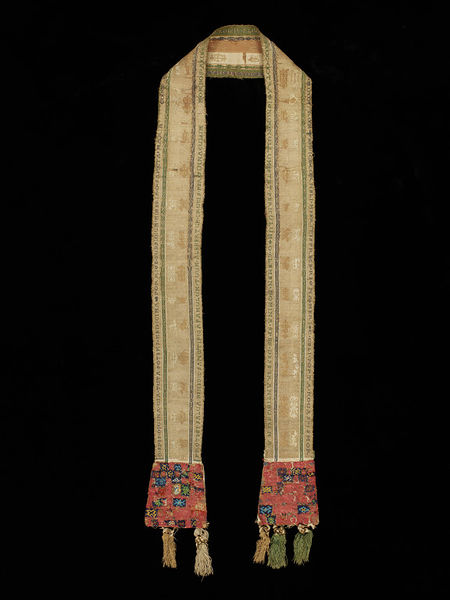
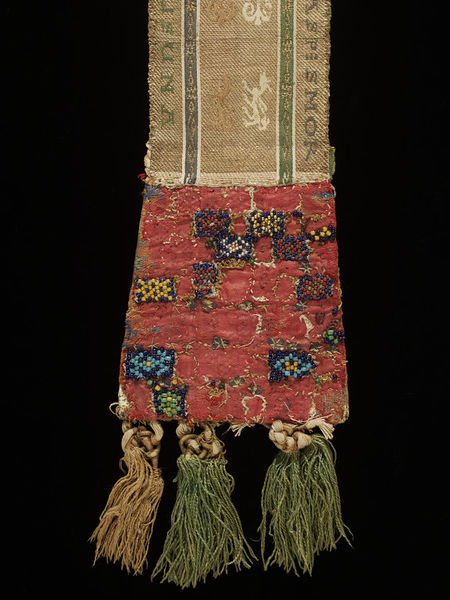
Stole
Place of origin:
Germany (made)
Date:
1250-1330 (made)
Artist/Maker:
Unknown (production)
Materials and Techniques:
Tablet-woven in silk and gold, with bead embroidery and painted motif on silk lined with parchment or leather
Museum number:
8588-1863
The maniple has been part of liturgical dress for Roman Catholic deacons, priests and higher clergy since the 9th century. It is worn hung over the left forearm and was probably carried as a formal sign of office. It echoes the shape and decoration of the longer stole which is usually worn around the neck.
A long narrow band, broadening at the ends to a trapezoid shape and finished with fringes, it usually has a device at each end. In this case, the beaded embroidery comprises a striking geometric pattern. Specifically religious references are evident in the small painted image of the Virgin and Child on the left end, and the wording woven into the strip that went round the neck.
http://collections.vam.ac.uk/item/O1667 ... e-unknown/
Là, je craque...c'est "méd" : VIIIème, mais pas "chez nous"...
Stein fût archéologue sur la route de la soie, et, il n'y a pas à dire, mais les conditions de conservation du désert du Taklamakan, c'est plutôt bien!
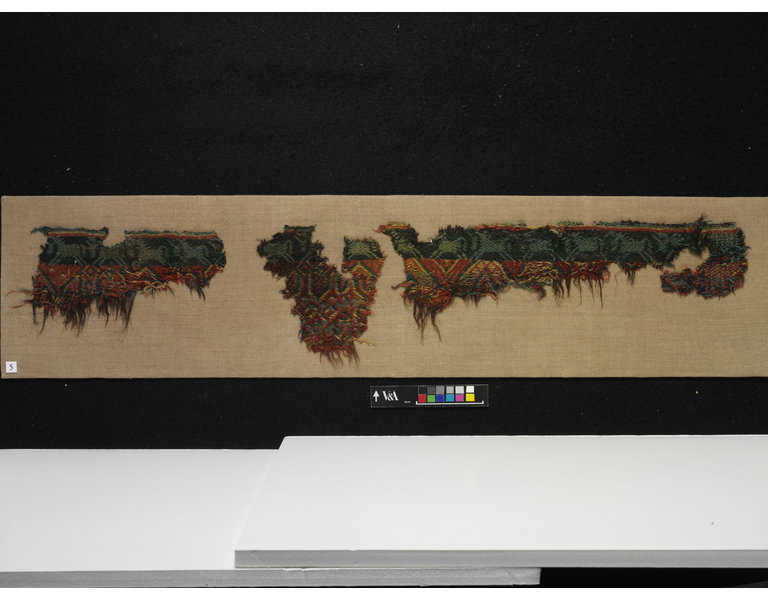
Place of origin:
Miran Fort, China (excavated)
Date:
8th century (made)
Artist/Maker:
Unknown (production)
Materials and Techniques:
Tablet weavin, and stitching
Credit Line:
Stein Textile Loan Collection. On loan from the Government of India and the Archaeological Survey of India. Copyright: Government of India.
These three fragments are from a tablet woven border. The upper part shows running horses in pale blue on dark blue ground and below a reddish part with geometrical figures. It is unclear what these fragments would have been used for, although they are likely to have had a decorative purpose. They were reovered from the site of Miran Fort on the eastern verge of the Taklamakan desert. At this site material was discovered in the remains of a fort held by the Tibetans during their domination of the southern Taklamakan in the 8th century AD.
The site is also part of an area of Central Asia we now call the Silk Road, a series of overland trade routes that crossed Asia from China to Europe. The most notable item traded was silk. Camels and horses were used as pack animals and merchants passed the goods from oasis to oasis. The Silk Road was also important for the exchange of ideas. Whilst silk textiles travelled west from China, Buddhism entered China from India in this way.
This textile was brought back from Central Asia by the explorer and archaeologist Sir Marc Aurel Stein (1862-1943). The V&A has around 650 ancient and medieval textiles recovered from the Silk Road by Stein at the beginning of the20th century. Some are silk while others are made from the wool of a variety of different animals
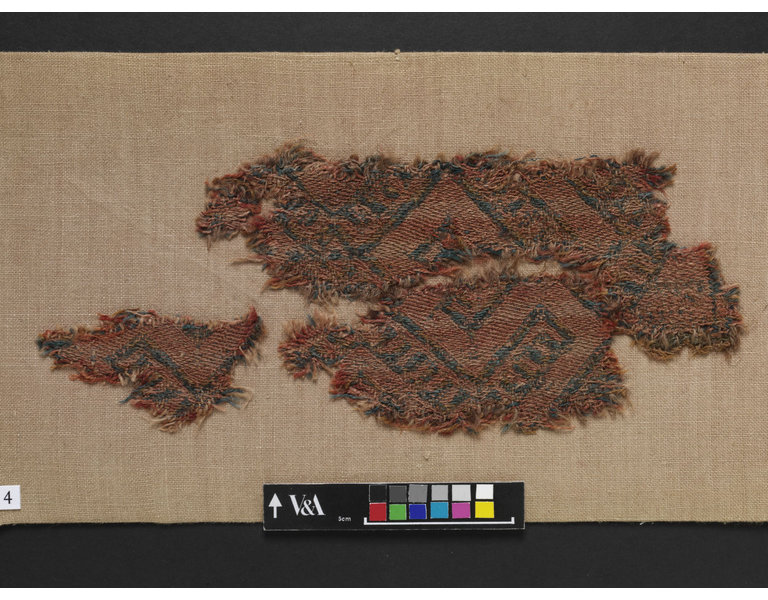
Place of origin:
Miran Fort, China (excavated)
Date:
8th century (made)
Artist/Maker:
Unknown (production)
Materials and Techniques:
Tablet woven wool
These fragments are of tablet woven blue and red wool showing a geometric design.
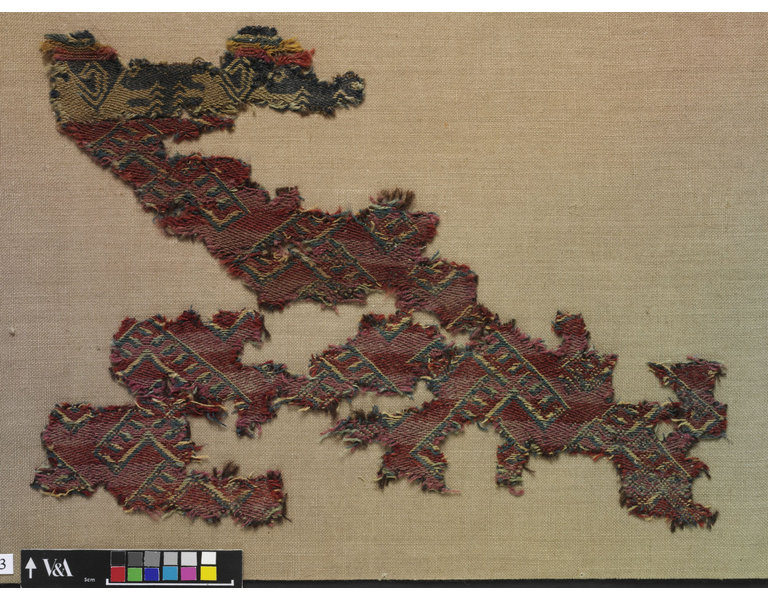
This piece consists of two textiles stitched together with brown wool thread. Both are tablet woven bands, one showing a row of animals in cream on blue. The other showing a geometric design. It is unclear what this piece would have been used for, although it is likely to have had a decorative purpose. It was recovered from the site of Miran Fort on the eastern verge of the Taklamakan desert. Many textile fragments were discovered here in the remains of a fort held by the Tibetans during their domination of the southern Taklamakan in the 8th century AD.
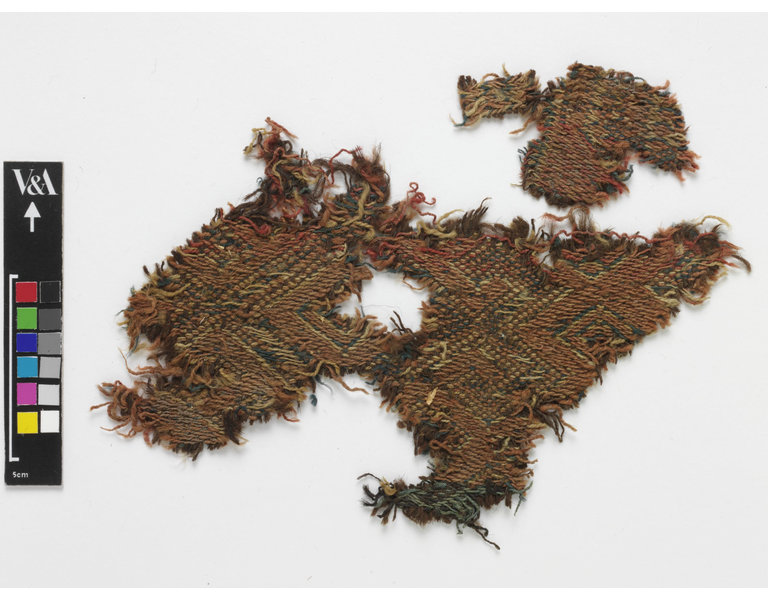
[img]These%20two%20textile%20fragments%20are%20of%20polychrome%20tablet%20weave,%20made%20of%20blue,%20yellow,%20red%20and%20dark%20brown%20wool%20and%20showing%20a%20version%20of%20the%20key%20pattern.%20It%20is%20unclear%20what%20these%20textiles%20would%20have%20been%20used%20for,%20althoughthey%20are%20likely%20to%20have%20had%20a%20decorative%20purpose%20as%20well%20as%20a%20utilitarian%20function.[/img]
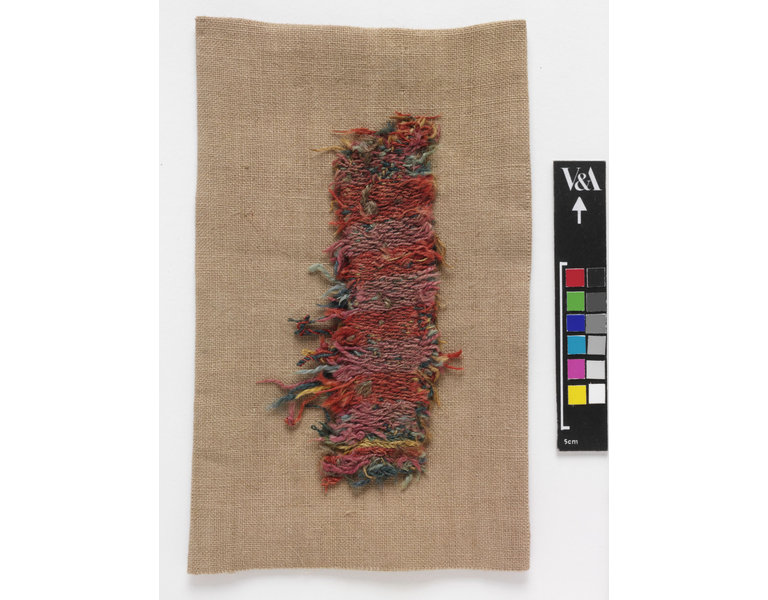
This textile fragment is of tablet woven wool in red, purple, light blue, dark blue, yellow and brown. It was recovered from the site of Miran Fort on the eastern verge of the Taklamakan desert. Many textile fragments were discovered here in the remains of a fort held by the Tibetans during their domination of the southern Taklamakan in the 8th century AD.
NB: ce désert a été un croisement intensif de cultures donc d'idées. C'est là, aussi, que des fouilles ont révélé la présence de caucasiens en déjà - 2700. Vu le sol et le climat, ces corps sont devenus des momies naturelles, et les textiles ont été remarquablement préservés, les couleurs aussi.
(cela fait un "moment" que je m'intéresse aux "ailleurs" et "autres moments", c'est honteux, je sais...)
Niveau galons à cartes trouvés par Stein, on constate que il y a du sophistiqué, du figuratif, du "géométrique" et du "bête galon" basique...
repartons dans "notre" MA:
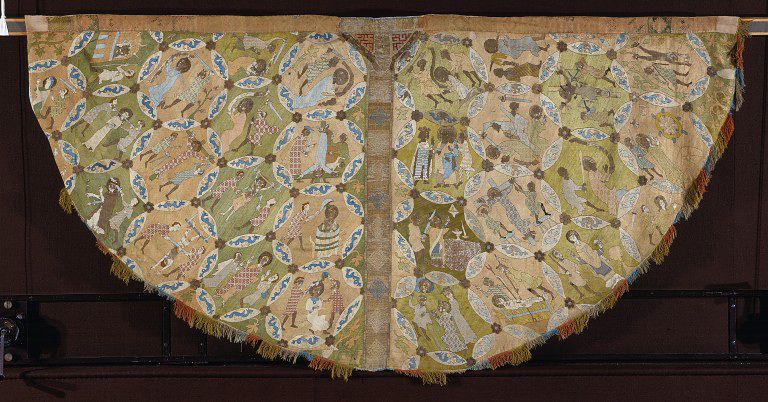
The Hildesheim Cope
Cope
Place of origin:
Germany (made)
Date: 1310-1320 (made)
Artist/Maker:
Unknown (production)
Materials and Techniques:
Embroidered in silks on linen, with couched metal thread, pattern woven and tablet woven silk and metal thread, applique
This cope has a fascinating, albeit gruesome, depiction of saints undergoing various forms of martyrdom. All sorts of infamous medieval torture methods are represented such as flaying (of St Bartholomew), roasting (of St Lawrence), several crucifixions (among others St Peter), variations of stabbings, clubbings and beheadings (most famously St Thomas Becket).
Each saint is within a roundel. These roundels intersect with each other so as to form six-pointed star shapes, separated by spaces between the points of oval shape. In these small spaces there are blue dragons with red wings and at each point of the star shape are appliqued golden rosettes. Embroidery in polychrome silks and couched gold thread, entirely covers the linen background. Compared with known examples of contemporary Opus Anglicanum, this German work is rather naive and not as finely executed.
On aurait aussi pu mettre cette cape dans "torture" vu toutes les façons de trucider, ici en la matière, des saints.
VAM: http://collections.vam.ac.uk/technique/ ... aving/538/

